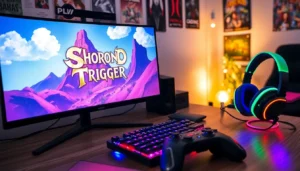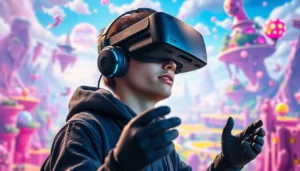Table of Contents
ToggleImagine your favorite characters from different worlds colliding in a spectacular showdown. Licensed crossover events bring this fantasy to life, creating thrilling experiences that fans can’t resist. These events not only bridge universes but also spark creativity and excitement, giving fans a chance to see beloved heroes and villains interact in ways they never thought possible.
Overview of Licensed Crossover Events
Licensed crossover events involve characters from distinct universes engaging in compelling interactions. These events often occur in comics, video games, and television shows, allowing characters like superheroes and villains to meet in unique scenarios. Fans eagerly anticipate these moments, as they blend narratives and appeal to diverse audiences.
Significant licensed crossover events, such as “Avengers vs. X-Men,” showcase how different character dynamics can create rich storytelling opportunities. In the realm of video games, titles like “Super Smash Bros.” exemplify crossovers by featuring iconic characters from various franchises battling one another. Such interactions foster creative collaborations, producing fresh content that attracts fan engagement.
Furthermore, these events often inspire new merchandise, thereby expanding the reach of each franchise. Collaborations between companies like Marvel and Capcom highlight the financial and creative benefits of these licensed events. Employers recognize that fan enthusiasm drives interest and sales, bolstering the success of both brands involved.
Exploring the impact of these crossovers reveals their role in enhancing fan experiences. The ability to witness characters with contrasting personalities face off or team up generates excitement. This unpredictability keeps audiences engaged and promotes ongoing discussions around beloved franchises.
Overall, licensed crossover events create a platform for creativity, encouraging new stories and fostering deeper connections among fans. Through strategic partnerships, companies continue to explore innovative ways to captivate audiences, ensuring these events remain a staple in entertainment culture.
Mechanisms Behind Licensed Crossover Events

Licensed crossover events thrive on intricate mechanisms that enhance storytelling. These events offer unique interactions that captivate audiences across various mediums.
Role of DNA Repair Proteins
DNA repair proteins play a crucial part in maintaining genomic integrity during licensed crossover events. These proteins, including BRCA1 and RAD51, ensure effective double-strand break repair. By facilitating homologous recombination, they promote accurate genetic exchanges. Such exchanges create hybrid characters that amplify narrative complexity. The presence of these proteins allows for seamless integration of divergent storylines, transforming simple crossover interactions into intricate plots that resonate with fans.
Influence of Cell Cycle Phases
Cell cycle phases significantly influence the occurrence of licensed crossover events. For instance, the S phase fosters DNA replication, preparing cells for potential genetic recombination. This phase allows for higher DNA repair activity, which is essential during crossovers. Meanwhile, the G2 phase ensures proper checkpoint control, enabling cells to address any DNA damage prior to division. Coordination between these phases enhances the likelihood of successful crossovers, making the transitions between character universes more engaging and believable for fans. Each phase contributes to a dynamic environment that stimulates creative narratives.
Importance of Licensed Crossover Events
Licensed crossover events significantly enhance storytelling through the merging of diverse characters. These events facilitate richer narratives that captivate audiences across various media.
Genetic Diversity and Evolution
Genetic diversity plays a key role in licensed crossover events. Characters from different franchises often feature unique abilities and traits, creating opportunities for unexpected alliances. Blending these diverse characteristics fosters innovative storytelling. Evolutionary themes arise as characters adapt and grow through their interactions. This dynamic reveals the potential for hybrid characters, enriching narrative layers and exploring the nuances of identity. Franchises benefit as they tap into varied audiences, attracting fans from different backgrounds and interests.
Implications in Disease and Therapy
Crossover events can also reflect real-world implications in disease and therapy. The interaction of distinct characters highlights the importance of collaboration, mirroring how scientists combine approaches to tackle complex health issues. For example, merging knowledge from different franchises can symbolize breakthroughs in understanding diseases. The representation of characters overcoming challenges collectively resonates with audiences, emphasizing the significance of unity in addressing health concerns. By extending these themes within storytelling, creators motivate conversations about health, wellness, and collaboration in society.
Current Research Trends
Research trends in licensed crossover events increasingly emphasize the significance of character dynamics. Recent studies focus on how these interactions enhance storytelling and engage audiences. Analysis of franchises shows that blending narratives attract diverse fan bases.
Experimental work highlights the role of genetic diversity in character creation. Collaborations among creators lead to innovative hybrids, enriching plotlines. These hybrids often explore complex themes of identity and morality.
Investigations also reveal that audience engagement spikes during major crossover events. Fans actively respond to unexpected character encounters, reflecting the effectiveness of creative synergy. The excitement around these crossovers aligns with broader trends in interactive storytelling.
Recent data points to the importance of strategic partnerships among franchises. Companies leverage these collaborations to maximize reach and product offerings. Significant merchandise growth results from successful licensed events, underscoring their economic impact.
Emerging research identifies patterns in fan expectations. Crossovers featuring contrasting personalities generate heightened anticipation. These expectations guide creators in producing compelling narratives that resonate with viewers.
Additionally, technological advancements enable creators to explore new storytelling formats. Virtual and augmented reality applications create immersive crossover experiences. These innovations often set the stage for expanded narrative possibilities.
Current literature also discusses the role of licensed crossover events in public health messaging. By weaving health themes into character interactions, creators foster dialogue about wellness. This approach reflects how entertainment can address societal issues, enhancing relevance in modern culture.
Future Perspectives and Challenges
Emerging trends in licensed crossover events reveal both opportunities and challenges. Innovation continues to drive the creative landscape, inviting fresh character interactions that excite fans. However, coordinating multiple franchises can complicate the development process.
Effective collaboration remains crucial for producing successful crossover narratives. Strategic partnerships must prioritize mutual interests to enhance product offerings and increase merchandise growth. While blending diverse characters fosters engaging storytelling, balancing varying tones from different source materials proves challenging.
Character dynamics generate heightened audience anticipation during major crossover events. Exploring contrasting personalities not only captivates fans but also complicates character arcs. As technological advancements enable new storytelling formats, creators face the challenge of integrating these innovations seamlessly into existing narratives.
Market research indicates shifting fan expectations, with audiences desiring more intricate interactions. Participating franchises must adapt to these demands to remain relevant in a competitive landscape. Integrating public health messages within crossover storylines can enhance societal relevance while promoting wellness through entertainment.
Creative synergy strengthens audience engagement, yet diverse fan bases require careful navigation. Formulating narratives that resonate across demographies presents unique difficulties. Future crossover events must find effective ways to balance accessibility with depth to captivate varied audiences.
Navigating intellectual property rights offers another challenge to franchises. Ensuring legal compliance while maintaining creative freedom limits some storytelling possibilities. Addressing these issues decisively will be essential for the successful continuation of licensed crossover events in the evolving entertainment landscape.
Licensed crossover events represent a vibrant intersection of creativity and storytelling. They not only captivate audiences but also encourage collaboration among franchises, allowing for innovative narratives that resonate with fans. As these events continue to evolve, they’ll likely push the boundaries of traditional storytelling, introducing new character dynamics and exploring complex themes.
The future of licensed crossovers hinges on effective partnerships and an understanding of fan expectations. By navigating challenges such as intellectual property rights and maintaining narrative coherence, creators can craft experiences that engage diverse audiences. Ultimately, these crossovers are more than just entertainment; they foster a sense of community and dialogue among fans, making them an integral part of modern pop culture.




